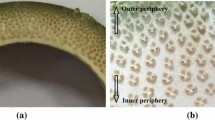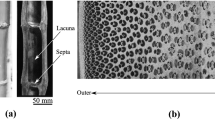Abstract
The mechanical behaviour of bamboo is greatly influenced by its transverse properties, which are not easily measured by experiment. This study develops a framework and the computational tools required to evaluate the material and mechanical properties of bamboo in its full-culm form. A numerical model of bamboo as a transversely isotropic material with functionally graded material properties in the radial direction is developed. The random field method was introduced as a means of quantifying the measured uncertainty of bamboo with respect to the mechanical characterisation of its full-culm state. Four increasingly complex approaches to model circumferential compression tests of bamboo are presented: a theoretical evaluation using Castigliano’s theorem; an orthotropic model neglecting the graded nature of the culm wall; and, two models—one discrete and one continuum-based that define a transversely isotropic graded material. Output from each model is compared, calibrated and validated with experimental results. While the models developed were robust, their application has drawn into question the fundamental hypothesis that the functionally graded behaviour of bamboo can be captured using the rule of mixtures.







Similar content being viewed by others
References
ABAQUS (2017) ABAQUS version 6.12 Computer Software. Dassault Systems, USA.
Abrahamsen P (1997) A review of gaussian random fields and correlation functions. In: Technical report 917, Norwegian Computing Center, Oslo
Agarwal M, Mehra R (2014) Review of matrix decomposition techniques for signal processing applications. Int J Eng Res Appl 4(1):90–93
Akinbade Y (2020) Mechanical and morphological characterization of full-culm Bamboo. In: Ph.D. Dissertation, University of Pittsburgh, p. 202
Akinbade Y, Harries KA, Sharma B, Nettleship I, Ramage M (2020) Variation of through-culm wall morphology in P. edulis bamboo strips used in glue-laminated bamboo beams. Constr Build Mater 232:117248
Akinbade Y, Harries KA, Flower C, Nettleship I, Papadopoulos C, Platt SP (2019) Through-Culm wall mechanical behaviour of bamboo. Constr Build Mater 216:485–495
Alder RJ, Taylor JE (2010) Random fields and geometry. Springer, New York
Amada S, Munekata T, Nagase Y, Ichikawa Y, Kirigai A, Yang Z (1996) The mechanical structures of bamboos in viewpoint of functionally gradient and composite materials. J Compos Mater 30(7):800–819
Amada S, Untao S (2001) Fracture properties of bamboo. Compos B 32:451
Bower AF (2009) Applied mechanics of solids. CRC Press, New York
Caro S, Castillo D, Sanchez-Silva M (2014) Methodology for modeling the uncertainty of material properties in asphalt pavements. ASCE J Mater Civ Eng 26(3):440–448
Correal JFD, Arbeláez C (2010) Influence of age and height position on Colombian Guadua angustifolia bamboo mechanical properties. Maderas Ciencia y tecnología 12(2):105–113
El-Kadi AI, Williams SA (2000) Generating two-dimensional fields of autocorrelated, normally distributed parameters by the matrix decomposition method. Ground Water 38(4):530–532
García JJ, Rangel C, Ghavami K (2012) Experiments with rings to determine the anisotropic elastic constants of bamboo. Constr Build Mater 31:52–57
Gauss C, Savastano H, Harries KA (2019) Use of ISO 22157 mechanical test methods and the characterisation of Brazilian P. edulis bamboo. Constr Build Mater 228:116728
Ghavami K, Rodriques CS, Paciornik S (2003) Bamboo: functionally graded composite material. Asian J Civ Eng (Build Housing) 4(1):1–10
Gonzalez MG, Madden J, Maluk C (2018) Experimental study on compressive and tensile strength of bamboo at elevated temperatures. In: World conference on timber engineering, August 20–23, Seoul
Habibi MK, Lu Y (2014) Crack propagation in Bamboo’s hierarchical cellular structure. Nat Sci Rep 4:5598. https://doi.org/10.1038/srep05598
Halpin JC, Kardos JL (1976) The Halpin-Tsai equations: a review. Polym Eng Sci 16(5):344–352
Harries KA, Bumstead J, Richard MJ, Trujillo D (2017) Geometric and material effects on bamboo buckling behaviour. ICE Struct Build 170(4):236–249
Hewitt RL, Malherbe MC (1970) An approximation for the longitudinal shear modulus of continuous fiber composites. Compos Mater 4:280
ISO (2019) ISO 22157:2019: Bamboo structures—Determination of physical and mechanical properties of bamboo culms. International Standards Organization, Geneva, Switzerland
ISO (2018) ISO 19624:2018 Bamboo structures—Grading of bamboo culms – Basic principles and procedures. International Standards Organization, Geneva, Switzerland
Janssen JA (1981) Bamboo in building structures. Doctoral Thesis. Eindhoven University of Technology, Netherlands
Janssen JA (2000) Designing and building with bamboo. International Network for Bamboo and Rattan, Technical Report No. 20
Kim H (2005) Spatial variability of soils: stiffness and strength. Ph.D. Dissertation. Georgia Institute of Technology
Kim JH, Paulino GH (2002) Isoparametric graded finite elements for nonhomogeneous isotropic and orthotropic materials. J Appl Mech 69(513):502–514
Liese W (1998) The anatomy of bamboo culms. International Network for Bamboo and Rattans (INBAR), Beijing, Technical report No, p 18
Lorenzo R, Mimendi L, Li H, Yang D (2020) Bimodulus bending model for bamboo poles. Constr Build Mater 262:120876
Low IM, Che ZY, Latella BA (2006) Mapping the structure, composition and mechanical properties of bamboo. J Mater Res 21:1969–1976
Martínez-Pañeda E, Gallego R (2015) Numerical analysis of quasi-static fracture in functionally graded materials. Int J Mech Mater Des 11(4):405–424
Moran R, Webb K, Harries KA, Garcia JJ (2017) Edge bearing tests to characterize the radial gradation of bamboo. Constr Build Mater 131:574–584
Nogata F, Takahashi H (1995) Intelligent functionally graded material: Bamboo. Eng Compos 5:743
Richard MJ, Harries KA (2015) On inherent bending in tension tests of bamboo. Wood Sci Technol 49(1):99–119
Rousseau CE, Tippur HV (2000) Compositionally graded materials with cracks normal to the elastic gradient. Acta Mater 48:4021–4033
Santare MH, Lambros J (2000) Use of graded finite elements to model the behaviour of nonhomogeneous materials. ASME Trans J Appl Mech 67:819–822
Sattar MA, Kabir MF, Bhattacharjee DK (1990) Effect of age and height position of muli (Melocanna baccifera) and borak (Bambusa balcooa) bamboos on their physical and mechanical properties. Bangladesh J For Sci 19(1/2):29–37
Sekhar AC, Bhartari RK (1960) Studies on strength of bamboos: a note on its mechanical behavior. Indian Forest 86:296–301
Shao ZP, Fang CH, Huang SX, Tian GL (2010) Tensile properties of Moso bamboo (Phyllostachys pubescens) and its components with respect to its fiber-reinforced composite structure. Wood Sci Technol 44:655–666
Sharma B, Harries KA, Ghavami K (2013) Methods of Determining Transverse Mechanical Properties of Full-Culm Bamboo. Constr Build Mater 38:627–637
Shigematsu Y (1958) Analytical investigation of the stem form of the important species of bamboo. Bull Faculty Agric Univ Miyazaki 3:124–135 ((in Japanese))
Silva ECN, Walters MC, Paulino GH (2006) Modeling bamboo as a functionally graded material: lessons for the analysis of affordable materials. J Mater Sci 41(21):6991–7004
Torres LA, Ghavami K, Garcia JJ (2007) A transversely isotropic law for the determination of the circumferential young’s modulus of bamboo with diametric compression tests. Latin Am Appl Res 37(4):255–260
Van Der Lugt P, Van den Dobbelsteen AAJF, Abrahams R (2003) Bamboo as a building material alternative for Western Europe? A study of the environmental performance, costs and bottlenecks of the use of bamboo (products) in Western Europe. J Bamboo Rattan 2(3):205–223
Vittouris A, Richardson M (2011) Designing vehicles for natural production: growing a velomobile from bamboo. In: Australasian transport research forum, pp 28–30
Xu Q, Harries K, Li X, Liu Q, Gottron J (2014) Mechanical properties of structural bamboo following immersion in water. Eng Struct 81:230–239
Young WC, Budynas RG, Sadegh AM (2002) Roark’s formulas for stress and strain, vol 7. McGraw-Hill, New York
Acknowledgements
The authors acknowledge the support of the United States National Science Foundation (award number CMMI 1634739).
Author information
Authors and Affiliations
Corresponding author
Ethics declarations
Conflict of interest
On behalf of all authors, the corresponding author states that there is no conflict of interest.
Additional information
Publisher's Note
Springer Nature remains neutral with regard to jurisdictional claims in published maps and institutional affiliations.
Electronic supplementary material
Below is the link to the electronic supplementary material.
Rights and permissions
About this article
Cite this article
Akinbade, Y., Nettleship, I., Papadopoulos, C. et al. Modelling full-culm bamboo as a naturally varying functionally graded material. Wood Sci Technol 55, 155–179 (2021). https://doi.org/10.1007/s00226-020-01246-6
Received:
Accepted:
Published:
Issue Date:
DOI: https://doi.org/10.1007/s00226-020-01246-6




